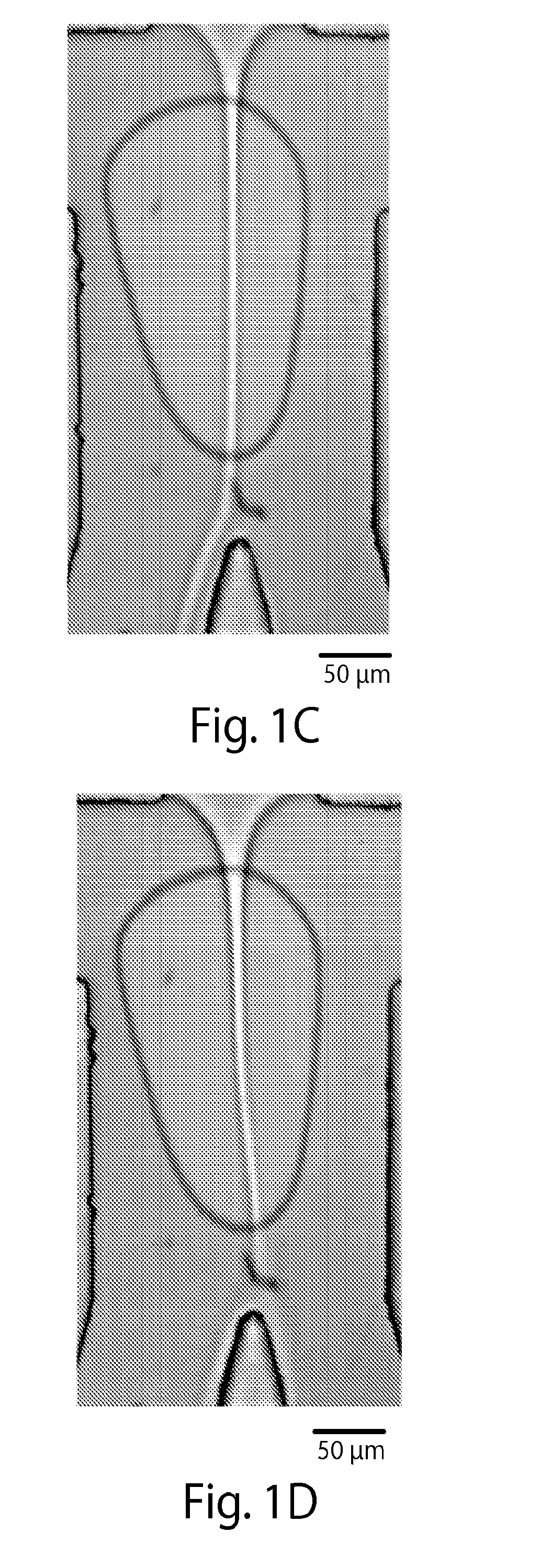Acoustic waves in microfluidics
a microfluidic and acoustic wave technology, applied in the field of acoustic waves in microfluidics, can solve the problems of high cost, large dead volume, and the effect of sorting on the dropl
- Summary
- Abstract
- Description
- Claims
- Application Information
AI Technical Summary
Benefits of technology
Problems solved by technology
Method used
Image
Examples
example 1
[0081]This example describes a microfluidic cell sorter which operates in continuous flow at high sorting rates. The device is based on a surface acoustic wave cell-sorting scheme and combines many advantages of fluorescence activated cell sorting (FACS) and fluorescence activated droplet sorting (FADS) in microfluidic channels. It is fully integrated on a PDMS device, and allows fast electronic control of cell diversion. Cells were directed by acoustic streaming excited by a surface acoustic wave which deflects the fluid independently of the contrast in material properties of deflected objects and the continuous phase; thus the device underlying principle works without additional enhancement of sorting by prior labeling of the cells with responsive markers such as magnetic or polarizable beads. Single cells were sorted directly from bulk media at rates as fast as several kHz (thousands of droplets per second) without prior encapsulation into liquid droplet compartments as in tradit...
example 2
[0101]Pumps are among the key components to actuate as well as control flow in microfluidic systems. There are a multitude of pumps that have been developed, exploiting various physical effects. Among these are pumps using electrophoretic or dielectrophoretic forces, capillary, magnetic forces, or mechanical techniques creating hydrodynamic pressure gradients to drive fluid flow. This example presents a pumping technique based on an acoustic streaming effect. This method shows tubeless fluid control without any external fluid connection, and pumping at high flow rates. The actuation principle used here is based on a SAW-induced counterflow mechanism and the effect of nebulization anisotropy, and relies on the droplet dynamics at the air-liquid interface.
[0102]Using this counterflow effect where SAW propagation and fluid actuation are oppositely directed, fluid was drawn from a reservoir into a channel and moved to a position in the array. The actuation principle of acoustic streamin...
example 3
[0114]In this example, fluorescence-actuated sorting of 25 micrometer-diameter droplets into 3 different outlets is demonstrated. FIGS. 7A-7C show an overlay of consecutive images of a single droplet passing through the sorting device from the inlet (1) to the different outlets (2). In other words, the trajectories of a droplet going up, a droplet going straight and a droplet going down are shown to illustrate sorting into different channels or locations. It should be noted that typically, the droplets are sorted one by one. Device fabrication and operation was generally similar to that described in the previous examples, and used many of the same materials and operating conditions.
[0115]In these experiments, the fluorescence intensity of droplets was measured in a laser spot (3). Depending on fluorescence intensity, the droplets were deflected upwards (4) toward the upper outlet (FIG. 7A), downwards (5) toward the lower outlet (FIG. 7C), or not deflected and allowed to pass to the ...
PUM
| Property | Measurement | Unit |
|---|---|---|
| average frequency | aaaaa | aaaaa |
| average frequency | aaaaa | aaaaa |
| average frequency | aaaaa | aaaaa |
Abstract
Description
Claims
Application Information
 Login to View More
Login to View More - R&D
- Intellectual Property
- Life Sciences
- Materials
- Tech Scout
- Unparalleled Data Quality
- Higher Quality Content
- 60% Fewer Hallucinations
Browse by: Latest US Patents, China's latest patents, Technical Efficacy Thesaurus, Application Domain, Technology Topic, Popular Technical Reports.
© 2025 PatSnap. All rights reserved.Legal|Privacy policy|Modern Slavery Act Transparency Statement|Sitemap|About US| Contact US: help@patsnap.com



